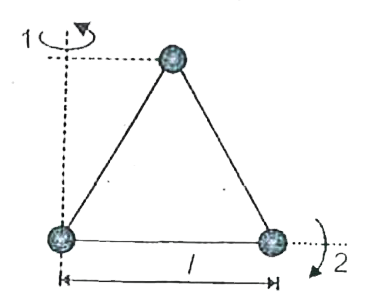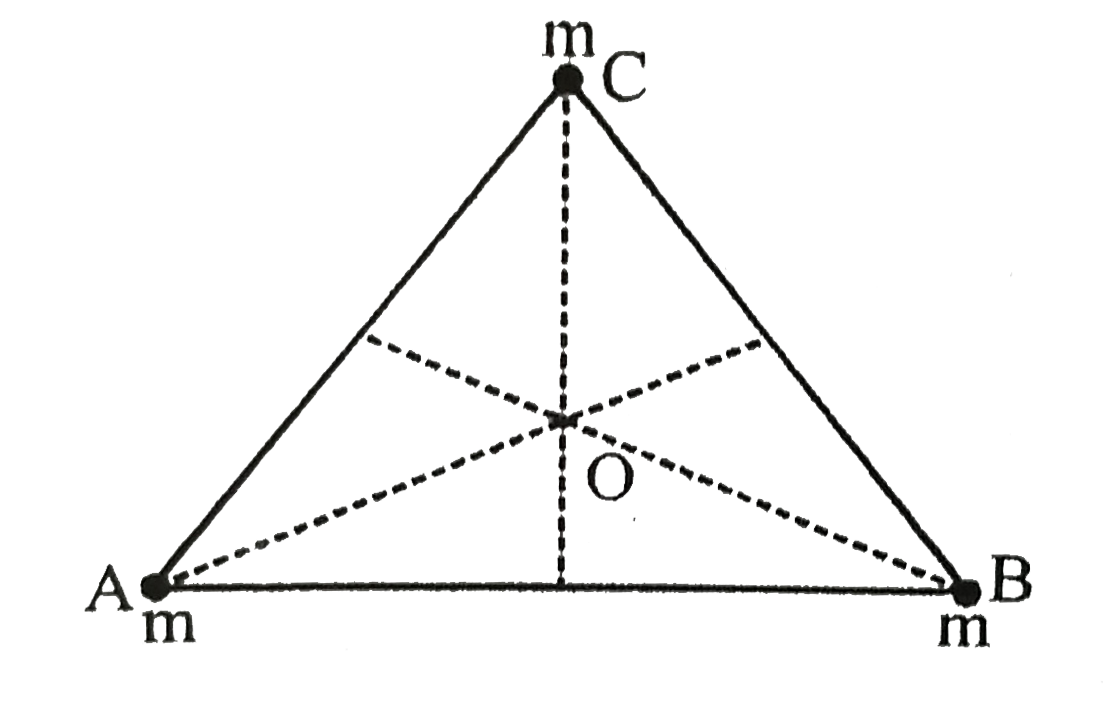Three identical bodies (each mass M) are placed at vertices of an equilateral triangle of arm L, keeping the triangle as such by which angular speed the bodies should rotated in their gravitional fields so that the triangle moves along circumference of circular orbit :
√3GML3
√GML3
√GM3L3
3√GML3
The correct Answer is:A
To solve the problem, we need to find the angular speed (ω) at which three identical bodies (each of mass M) placed at the vertices of an equilateral triangle of side length L should rotate in their gravitational fields so that the triangle moves along the circumference of a circular orbit.
1. Understanding the Forces:
- Each body experiences a gravitational force due to the other two bodies. This gravitational force (F_g) is attractive.
- The bodies also require a centripetal force (F_c) to maintain circular motion.
2. Gravitational Force Calculation:
- The gravitational force between two masses M separated by a distance L is given by:
Fg=GM2L2
- Since each mass experiences the gravitational pull from the other two masses, the resultant gravitational force acting on one mass due to the other two can be calculated.
3. Resultant Gravitational Force:
- The angle between the lines connecting the masses is 60 degrees (since it’s an equilateral triangle).
- The resultant force (F) from the two gravitational forces can be calculated using vector addition:
F=2Fgcos(30∘)=2(GM2L2)(√32)=√3GM2L2
4. Centripetal Force Calculation:
- The centripetal force required to keep one mass in circular motion is given by:
Fc=Mω2r
- The radius (r) of the circular path for the triangle can be derived as:
r=L√3
- Therefore, the centripetal force becomes:
Fc=Mω2(L√3)
5. Setting Forces Equal:
- For the triangle to maintain its circular motion, the resultant gravitational force must equal the centripetal force:
√3GM2L2=Mω2(L√3)
6. Solving for Angular Speed (ω):
- Cancel M from both sides:
√3GML2=ω2(L√3)
- Rearranging gives:
ω2=√3GML2⋅√3L=3GML3
- Taking the square root:
ω=√3GML3
Final Answer:
The angular speed (ω) at which the bodies should rotate is:
ω=√3GML3
- Each body experiences a gravitational force due to the other two bodies. This gravitational force (F_g) is attractive.
- The bodies also require a centripetal force (F_c) to maintain circular motion.
- The gravitational force between two masses M separated by a distance L is given by:
Fg=GM2L2
- Since each mass experiences the gravitational pull from the other two masses, the resultant gravitational force acting on one mass due to the other two can be calculated.
- The angle between the lines connecting the masses is 60 degrees (since it’s an equilateral triangle).
- The resultant force (F) from the two gravitational forces can be calculated using vector addition:
F=2Fgcos(30∘)=2(GM2L2)(√32)=√3GM2L2
- The centripetal force required to keep one mass in circular motion is given by:
Fc=Mω2r
- The radius (r) of the circular path for the triangle can be derived as:
r=L√3
- Therefore, the centripetal force becomes:
Fc=Mω2(L√3)
- For the triangle to maintain its circular motion, the resultant gravitational force must equal the centripetal force:
√3GM2L2=Mω2(L√3)
- Cancel M from both sides:
√3GML2=ω2(L√3)
- Rearranging gives:
ω2=√3GML2⋅√3L=3GML3
- Taking the square root:
ω=√3GML3
The angular speed (ω) at which the bodies should rotate is:
ω=√3GML3
Topper's Solved these Questions
- GRAVITATIONBOOK - ALLENCHAPTER - GRAVITATIONEXERCISE - EXERCISE 2
26 Videos
- GRAVITATIONBOOK - ALLENCHAPTER - GRAVITATIONEXERCISE - EXERCISE 3
11 Videos
- GRAVITATIONBOOK - ALLENCHAPTER - GRAVITATIONEXERCISE - BOX-4
14 Videos
- GEOMETRICAL OPTICSBOOK - ALLENCHAPTER - GEOMETRICAL OPTICSEXERCISE - subjective
14 Videos
- KINEMATICS-2DBOOK - ALLENCHAPTER - KINEMATICS-2DEXERCISE - Exercise (O-2)
46 Videos
Similar Questions
Three particle each of mass m are placed at the corners of equilateral triangle of side l

Which of the following is/are correct ?
View SolutionThree particles each of mass m are kept at vertices of an equilateral triangle of side L. The gravitational field at centre due to these particle is
View Solution
Knowledge Check
Consider the charges q,q and -q placed at the vertices of an equilateral triangle of each side l. What is the force on each charge ?
Aq24√2πε0l2B−q24πε0l2Cq24πε0l2Dzero
Three identical charges are placed at the vertices of an equilateral triangle. The force experienced by each charge, (if k=14πε0) is
View SolutionThree identical point objects each of mass m are placed at the vertices of an equilateral triange of side l. What is the gravitational potential at the centre of the equilateral triangle due to the point masses?
View SolutionThree identical particles each of mass m are placed at the vertices of an equilateral triangle of side a. Fing the force exerted by this system on a particle P of mass m placed at the

(a) the mid point of a side
(b) centre of the triangle
View SolutionThree particles of equal mass 'm' are situated at the vertices of an equilateral triangle of side L. The work done in increasing the side of the triangle to 2L is
View SolutionThree identical rods, each of mass m and length l, form an equaliteral triangle. Moment of inertia about one of the sides is

View SolutionThree identical positive charges Q are arranged at the vertices of an equilateral triangle. The side of the triangle is a. Find the intensity of the field at the vertex of a regular tetrahedron of which the triangle is the base.
View SolutionThree poistive charges of equal value q are placed at the vertices of an equilateral triangle. The resulting lines of force should be sketched as in
View Solution
